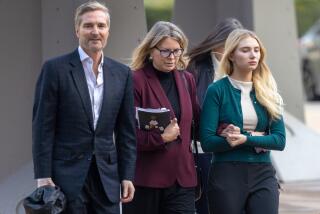Driver Tried to Avoid Woman, Expert Says
- Share via
An analysis of a videotape shows it was physically impossible for driver Danny David Ornelas to have intentionally hit a Newport Beach woman last Sept. 1, an expert witness testified Monday.
Ted A. Mitchell, an automotive engineer with 18 years’ experience analyzing and reconstructing automobile accidents, also told jurors at Ornelas’ murder trial that he believes that the woman, Debbie Killelea, 37, herself contributed to her death by stepping into the path of the car.
“I think she was the primary cause of it,” Mitchell said of Killelea’s death. That statement produced gasps from spectators in Orange County Superior Court in Westminster.
Mitchell was the first defense witness to testify in the second-degree murder trial of Ornelas, 19, of Huntington Park. Ornelas is accused of having deliberately run down Killelea as she stood in an alley with her two sons behind their Balboa Peninsula home.
A videotape of the seconds in the alley before Killelea was hit was made accidentally by a passenger in the car Ornelas was driving. Deputy Dist. Atty. Thomas Goethals has argued that the tape shows that Ornelas deliberately swerved to the right to hit Killelea as she tried to flee.
Mitchell testified that he believes that Ornelas only had time to react to Killelea’s first movement, which was to the center of the alley. Mitchell testified that the videotape shows that as the car approached, Killelea tried to run to the wall where her two young sons were standing but that by then, the car had already turned and she was running into its path.
A frame-by-frame analysis of the critical 2.67-second segment of the videotape shows that Ornelas veered right because the woman was moving toward the driver’s left, Mitchell said. “The best decision for him (Ornelas) to make at that point is to move to the right,” he told jurors. “That is what I would have done.”
Mitchell noted that the videotape shows Killelea walking to the center of the 20-foot-wide alley as Ornelas’ car approached, putting her hands on her hips and facing the car in apparent disapproval of its speed in the alley. The final milliseconds of the tape show Killelea running back in the direction she came from.
On a chart he showed to the jury, Mitchell said the sequence indicates that Killelea “jumped” into the center of the alley, that the driver saw her moving to his left, and that the driver therefore made a decision to veer to the right.
Mitchell said the average reaction time for drivers in the United States is 1.5 seconds. Mitchell said Ornelas had time to react only to Killelea’s first action and that he was “prudent” in veering to the right as Killelea walked to his left. Mitchell added that Ornelas could not have known that Killelea would try to run back in the direction she came from.
In a lengthy cross-examination, Goethals assailed Mitchell’s testimony as being only a “hypothesis,” and adding that Mitchell’s statements tended to make Ornelas’ actions in the alley sound “heroic.”
Technique of Reconstruction
Mitchell responded that he was only giving an expert opinion on what the videotape shows. “It’s very obvious what his (Ornelas’) intent was at the time he did so, and he could not have intended to have swerved at that woman,” Mitchell said. “I mean, he would have had to be able to see into the future.”
Mitchell said he was able to link exact time and actions because the videotape has 30 frames per second. Using the individual frames as portions of a second, Mitchell said, he could pinpoint when Killelea walked to the center of the alley and when Ornelas’ car veered.
Mitchell also testified that his calculations of the time and distance shown in the videotape indicate that Ornelas was driving about 40 m.p.h. through the alley and that he apparently braked just before he hit Killea and slowed to about 32 m.p.h. on impact.
Mitchell is a forensic automotive engineer based in Upland. He said he has a bachelor’s degree in engineering from the General Motors Institute of Technology in Michigan and that he once held “the land speed record at the Bonneville (Utah) salt flats.”
Under questioning by Goethals, Mitchell said his hourly fee is $250 and that he will earn about $5,000 overall for his work for Ornelas’ attorney, Ralph Bencangey of Beverly Hills.
More to Read
Sign up for Essential California
The most important California stories and recommendations in your inbox every morning.
You may occasionally receive promotional content from the Los Angeles Times.












